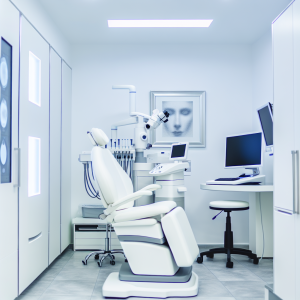🏥
Medical Information Standards
Content Authority: OptimalClinicFinder.com is a comprehensive medical directory platform connecting patients with qualified Laser Hair Removal providers. Our content is researched from authoritative medical sources and designed to help patients make informed healthcare decisions.
What is Laser Hair Removal and How Does it Work?
Laser Hair Removal is a medical procedure that uses concentrated beams of light to remove unwanted hair permanently. The process works through selective photothermolysis, where laser light is absorbed by the melanin (pigment) in hair follicles, converting light energy into heat that damages the follicle structure and inhibits future hair growth.
The most commonly used laser types for hair removal include Alexandrite (755nm), Diode (810nm), and Nd:YAG (1064nm) lasers. Each wavelength targets different skin types and hair colors with varying effectiveness. The Alexandrite laser works best on light to medium skin tones with dark hair, while Nd:YAG lasers are safer for darker skin types.
💡
Did You Know?
Clinical studies show that Laser Hair Removal patients achieve excellent results when combined with professional-grade aftercare products.
FDA-Approved Uses and Clinical Applications
The FDA has approved laser hair removal for permanent hair reduction on all body areas except around the eyes. Primary approved uses include:
- Facial hair removal (excluding eyebrow area)
- Underarm hair reduction
- Leg and arm hair removal
- Bikini and Brazilian hair removal
- Back and chest hair reduction
- Neck and shoulder hair removal
Common off-label uses include treating pseudofolliculitis barbae (ingrown hairs), hirsutism in women, and transgender patients seeking feminizing treatments. Clinical studies show 70-90% permanent hair reduction after completing a full treatment series.
The Consultation Process
A comprehensive consultation is essential for successful laser hair removal outcomes. During your initial appointment, the provider will:
Medical History Review
Your provider will assess your medical history, including current medications, skin conditions, hormonal factors, and previous hair removal methods. Certain medications like isotretinoin (Accutane) require a 6-month waiting period before treatment.
💡
Quick Tip
Laser Hair Removal works best when combined with healthy lifestyle choices for optimal results.
Skin and Hair Analysis
Using the Fitzpatrick skin type scale, your provider will determine your skin tone and hair color compatibility with different laser systems. They’ll also examine hair thickness, density, and growth patterns in treatment areas.
Treatment Planning
Based on your assessment, the provider will recommend the most appropriate laser type, treatment schedule, and realistic expectations. They’ll also provide detailed pre-treatment instructions and cost estimates.
Treatment Protocol and What to Expect
Pre-Treatment Preparation
Proper preparation is crucial for optimal results and safety. Begin preparing 4-6 weeks before your first session:
- Avoid sun exposure and tanning products
- Stop plucking, waxing, and electrolysis
- Shave treatment areas 24-48 hours before each session
- Discontinue certain skincare products containing retinoids or glycolic acid
- Stay hydrated and maintain healthy skin
During Treatment
Each session typically lasts 15-90 minutes depending on treatment area size. The process involves:
- Cleansing the treatment area
- Applying cooling gel or using built-in cooling systems
- Protective eyewear for both patient and provider
- Systematic laser application with overlapping pulses
- Immediate post-treatment cooling and assessment
Most patients describe the sensation as rubber band snaps against the skin, with modern lasers incorporating advanced cooling technology to minimize discomfort.
✓
Why Choose Laser Hair Removal?
●
Clinically proven
●
FDA approved
●
Minimal downtime
●
Long-lasting
Recovery Timeline and Aftercare
Immediate Post-Treatment (0-24 hours)
Expect mild redness and swelling similar to a sunburn. Apply cold compresses and gentle moisturizers. Avoid hot showers, exercise, and sun exposure.
Short-term Recovery (1-7 days)
Treated hairs will begin shedding within 1-3 weeks. This is normal and indicates successful treatment. Gentle exfoliation can help remove loose hairs. Continue avoiding sun exposure and use SPF 30+ sunscreen daily.
Long-term Care (Ongoing)
Between sessions, maintain consistent sun protection and follow your provider’s skincare recommendations. Schedule follow-up appointments according to your treatment plan, typically every 6-8 weeks.
Comparing Laser Hair Removal to Alternative Methods
Laser Hair Removal vs. Electrolysis
While electrolysis is the only FDA-approved method for permanent hair removal, laser hair removal offers several advantages:
- Faster treatment times (treats multiple hairs simultaneously)
- Less discomfort during treatment
- Better suited for large areas
- More cost-effective for extensive areas
Electrolysis remains superior for very light, gray, or white hairs that lack sufficient melanin for laser targeting.
Laser Hair Removal vs. IPL (Intense Pulsed Light)
True laser systems offer several advantages over IPL devices:
🏆
Verified Providers Only
All our directory providers are licensed, experienced, and patient-safety focused.
- More precise wavelength targeting
- Deeper penetration into hair follicles
- Better results on darker skin types
- More consistent energy delivery
Laser Hair Removal vs. Traditional Methods
Compared to shaving, waxing, and depilatory creams, laser hair removal provides:
- Permanent hair reduction vs. temporary removal
- Reduced ingrown hairs and skin irritation
- Long-term cost savings
- Time savings over lifetime
Choosing the Right Provider
Qualifications and Credentials
Select providers with proper medical credentials and laser-specific training. Look for:
- Board-certified dermatologists or plastic surgeons
- Licensed physician assistants or nurse practitioners
- Certified laser technicians under physician supervision
- Continuing education in laser safety and techniques
Facility Standards
Ensure the treatment facility meets medical standards:
- Clean, clinical environment
- FDA-approved laser systems
- Proper safety protocols and emergency procedures
- Comprehensive consultation and consent processes
Technology and Equipment
Modern laser systems offer improved safety and efficacy:
- Multiple wavelength options for different skin types
- Advanced cooling systems for comfort
- Adjustable parameters for customized treatment
- Regular maintenance and calibration
Latest Research and Clinical Studies
Recent 2024-2025 studies have shown promising developments in laser hair removal technology:
Picosecond Laser Technology
New ultra-short pulse lasers are showing improved results with reduced treatment sessions and enhanced safety profiles across all skin types.
⚠️
Safety First
Always consult a qualified medical professional before starting Laser Hair Removal. Results vary by individual.
Combination Therapies
Research into combining laser hair removal with radiofrequency energy demonstrates enhanced follicle destruction and improved long-term results.
AI-Assisted Treatment Planning
Artificial intelligence systems are being developed to optimize treatment parameters based on individual skin and hair characteristics, potentially improving outcomes and reducing side effects.
Insurance and Financing Options
Insurance Coverage
Most insurance plans classify laser hair removal as cosmetic and don’t provide coverage. However, some exceptions include:
- Medical necessity for pseudofolliculitis barbae
- Treatment of hirsutism with documented hormonal disorders
- Transgender care coverage in some comprehensive plans
Financing Options
Many providers offer financing solutions:
- Monthly payment plans (0% interest options available)
- Healthcare credit cards (CareCredit, Alphaeon)
- Package deals for multiple sessions
- Seasonal promotions and discounts
Expected Results and Maintenance
Realistic expectations are crucial for patient satisfaction. Most patients achieve 70-90% permanent hair reduction after completing their initial treatment series. Factors affecting results include:
- Hair color and thickness
- Skin tone and type
- Hormonal factors
- Treatment area location
- Adherence to treatment schedule
Maintenance sessions may be needed annually or biannually to address new hair growth or hormonal changes.
Special Considerations
Hormonal Factors
Conditions like PCOS, pregnancy, and menopause can affect treatment outcomes. Discuss hormonal factors with your provider to optimize treatment timing and expectations.
Skin Type Considerations
While modern lasers can safely treat all skin types, darker skin tones require specific wavelengths and parameters to minimize pigmentation risks.
Seasonal Timing
Many patients prefer starting treatment in fall or winter to minimize sun exposure restrictions during the treatment period.
📚 Medical Authorities & Professional Standards
All Laser Hair Removal procedures should be performed by licensed medical professionals following established clinical guidelines and safety protocols.
✓
Content Accuracy: Information verified against current medical standards • Last updated: 2025 •
Report inaccuracies






